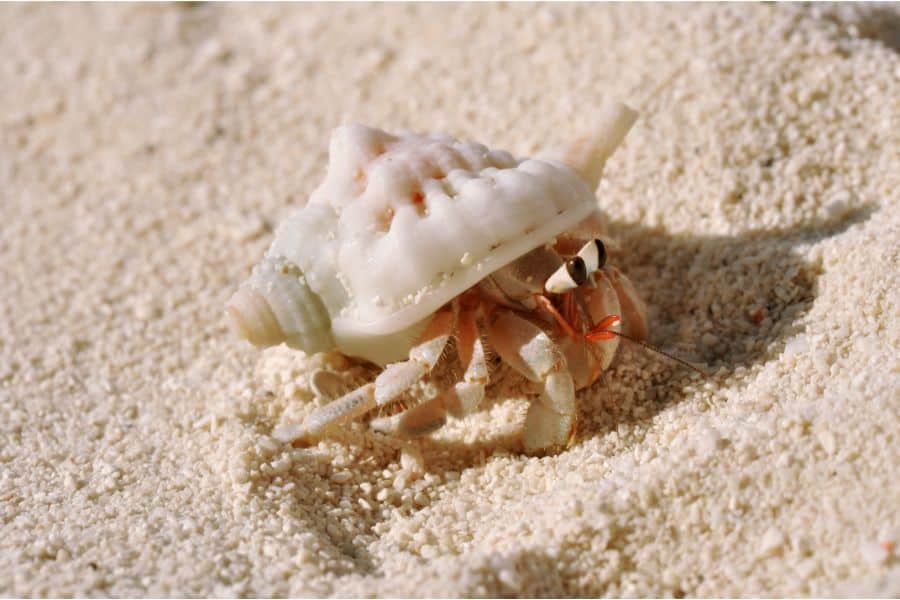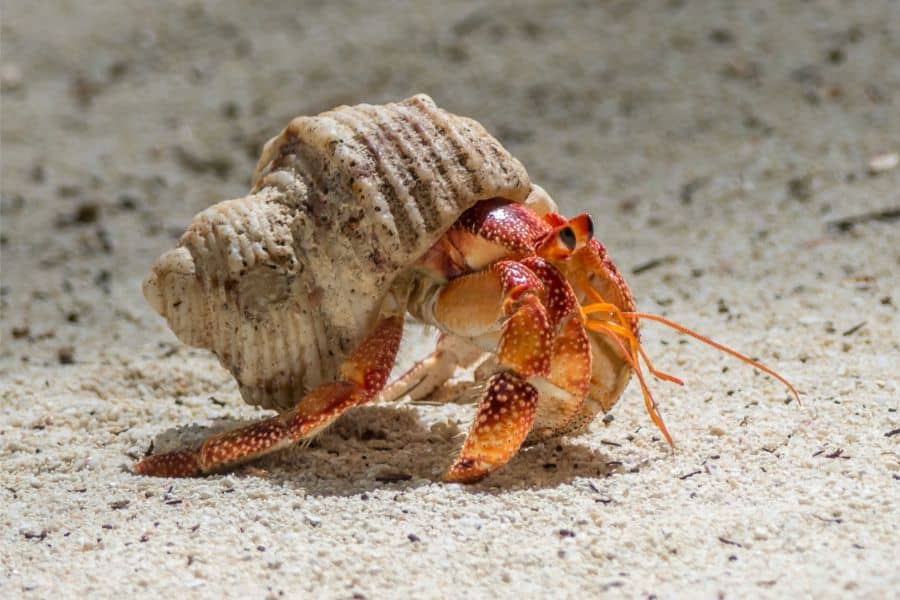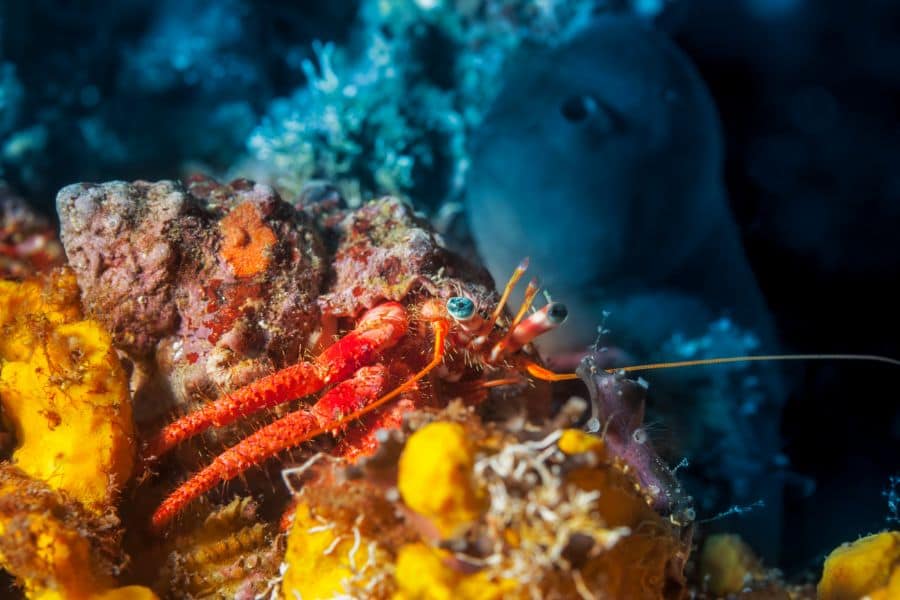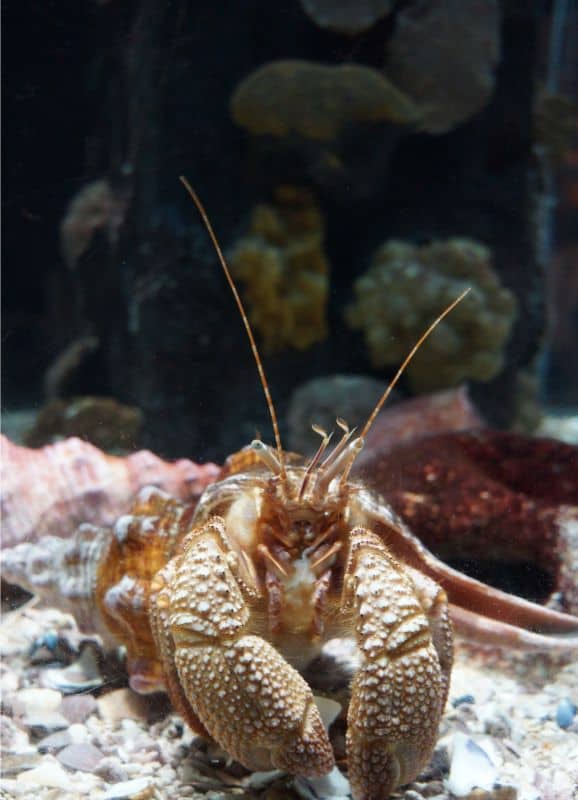Perhaps you’ve recently gone to the beach and picked up some hermit crabs because you thought they’d make a nice addition to your aquarium, however you’re not sure what they eat.
In this article, we’ll be going over exactly what hermit crabs eat, and how you can prepare them the best meals to ensure their survival at home.
Hermit crabs are opportunistic feeders that normally dine on things such as small fish, invertebrates, plankton, and other small food particles in the wild.
In captivity, they tend to eat a large variety of commercial and fresh food, in which you’ll have to feed them every day (though they can live up to 2 weeks without food).
Before going into their diet in detail, let’s first dive into the background of hermit crabs so that you’ll have a better understanding of why they eat what they eat.
What Are Hermit Crabs?
Hermit crabs (scientific name: Paguroidea) are a group of over 800 species that are spread throughout most of the world’s oceans. The land hermit crab (a type of semi-terrestrial hermit crab) is native to Bermuda, but is also found in Florida and across the Caribbean.
Hermit crabs are some of the least picky eaters you can find, consuming just about anything that surrounds them, such as small fish and invertebrates.
Some Background on Hermit Crabs
Though there are over 800 species of hermit crabs across the world, most people are only familiar with the roughly dozen or so land hermit crabs, which are the ones we mainly keep in our aquariums as pets. Hence, these will be the ones we’ll be taking a close look at in this article.
Hermit crabs, despite their name, are not true crabs because they neither have a uniformly hard exoskeleton nor the ability to grow their own shells. They’re more closely related to some types of lobsters than to actual crabs.
Instead of having a hard exoskeleton across their entire body, hermit crabs are limited to just the front part of their bodies (their tails on the other half are soft and vulnerable). To compensate, the hermit crabs use random discarded shells from other animals to protect their other half.
Hermit crabs use their curled tails to hook themselves into the borrowed shells, with smaller hermit crabs then taking over the old shells that the larger ones have abandoned.
General Diet Information
Hermit crabs are omnivorous scavengers, meaning that they will consume just about anything they come across, both plant and animal. Common kinds of foods that they eat include microscopic mussels, clams, animal corpses, and macroalgae.
Hermit Crab Reproduction Habits
Hermit crabs vary in mating habit, but they do not mate in human care.
Instead, they mate purely in seawater, where the male first holds the female with one claw while tapping/stroking her with the other. Both then partially emerge from their shells, while placing their stomachs together so that the male can transfer a sperm packet to the female, hence fertilizing her eggs.
The seawater causes the eggs to hatch and larvae to leave. The larvae will migrate to the shores once they reach adulthood.
Hermit Crab Threats
Typical threats for hermit crabs include plastic pollution (which can kill them) and, surprisingly perhaps, human captivity, the latter of which because pet stores mostly take hermit crabs straight from the wild, which is an unsustainable practice that can damage their ecosystem.
More details on hermit crabs (including their physical characteristics) can be found here.
More Hermit Carbs Diet
Because hermit crabs can have very extensive diets, this article will go into this in more detail so that you’ll know exactly what you should/shouldn’t feed your new hermit crab.
What Do Hermit Crabs Eat in The Wild?
In the wild, hermit crabs are omnivores, meaning they eat a combination of plant and animal matter. They are also scavengers, meaning they won’t search for anything in particular, but will rather consume just about anything that comes their way.
These two traits mean that hermit crabs have a very extensive diet that includes many kinds of small plant and animal matter. Some examples of the kinds of food they’ll eat include:
- Microscopic mussels and clams
- Dead animal parts (aka carrion)
- Macroalgae
- Nuts
- Various fruits and vegetables
- Garbage
- Their own molted shell
One thing they don’t eat though, is the former occupants of the shells that they’re using.
In the wild, hermit crabs find food mainly using two methods: one is to use the smelling receptors found on their antennae, and the other is to simply find food through observing what and where other fellow hermit crabs are eating.
What Do Hermit Crabs Eat as Pets?
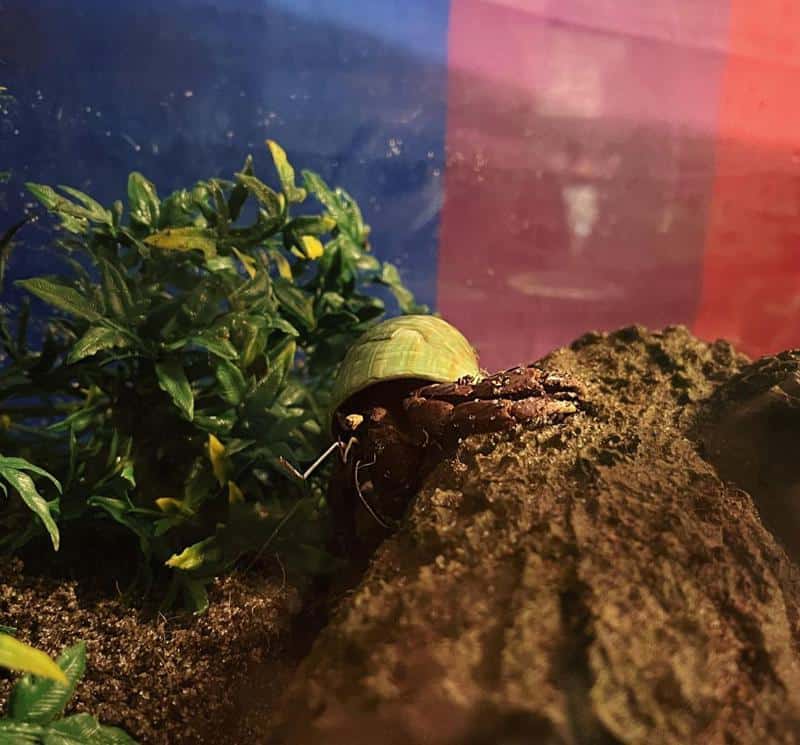
As pets, hermit crabs will typically eat a combination of commercial, fresh, and artificial/processed foods, with commercial and fresh foods providing most of the essential nutrients and vitamins that they need and artificial foods serving more as snacks/treats.
Commercial Foods
Commercially made foods that are specially geared towards hermit crabs will provide the bulk of the nutrients and vitamins that the crabs will need. The availability and type of commercial foods will depend on where you live and whether you can have access to them (many are now available for mail order however).
An example of a manufacturer of hermit crab based commercial food is Zoo-Med, which makes a pelleted diet, as well as canned food. Websites such as PetDiscounters.com carry commercial foods from Zoo-Med, and various other well-known manufacturers as well.
Pellets in particular should be crushed (and perhaps moistened) for smaller crabs, with uneaten food being removed daily.
Fresh Foods
Though commercial foods deliver most of what hermit crabs need to go about their day, they are often fond of a varied diet. Hence, here are some fresh foods to consider that are great supplements to their diet:
- Mango
- Papaya
- Coconut (fresh/dried)
- Apples
- Applesauce
- Melons
- Strawberries
- Carrots
- Spinach
- Watercress
- Green lettuce (not iceberg/head lettuce)
- Broccoli
- Nuts (unsalted)
- Seaweed
Keep in mind that this list is not exhaustive, and that most of these listed foods will need to be crushed, sliced, or otherwise divided up into smaller pieces for the hermit crabs to consume.
Artificial Foods
Artificial/processed foods should be given on a lesser basis. These are not as nutritious as the other foods we’ve discussed, and hence should only be given as treats from time to time.
Some examples include:
- Crackers (no or low salt)
- Peanut butter (rarely)
- Raisins
- Unsweetened cereals
- Popcorn (plain or air popped, to be given rarely)
- Plain rice cakes
Calcium-Enhancing Foods
There are some foods that are particularly helpful for hermit crabs in supporting the health of their exoskeleton. Some foods that provide calcium for your crabs include:
- Cuttlebone (whole or shredded; added to food)
- Calcium vitamin supplements (added to food)
- Crushed oyster shell
- Coral sand (tank substrate or supplement)
- Crushed egg shells (boil, dry, and crush the egg shells for a good source of calcium)
What Vegetables Do They Eat?
Hermit crabs can eat a large array of vegetables, including those high in vitamins and carotenoids, which give the crabs their brilliant skin colors. Some classic examples include:
- Carrots
- Bell peppers
- Cucumbers
- Various leafy greens
- Broccoli
- Asparagus
- Beans and Legumes
- Cauliflower
Again, this list is not exhaustive, but you should remember not to feed onions or garlic under any circumstances since these foods are toxic to hermit crabs.
You should also avoid feeding the same vegetables to the crabs every day since they’ll get tired of the same diet rather quickly.
What Can Hermit Crabs Not Eat?
Hermit crabs have very extensive diets, however there are a number of foods that should not be given since they either provide very little nutritional value or are potentially harmful to them. Notable examples include:
- Highly acidic/citrus foods (i.e. tomatoes, oranges, lemons, etc.)
- Starchy vegetables (i.e. parsnip, peas, potatoes)
- Iceberg lettuce (provides very little nutritional value compared to other types of lettuce)
- Any type of dairy product
- Particularly salty, fatty, or sugary snacks (i.e. pretzels, chips, sweetened cereal)
How Often Do Hermit Crabs Eat?
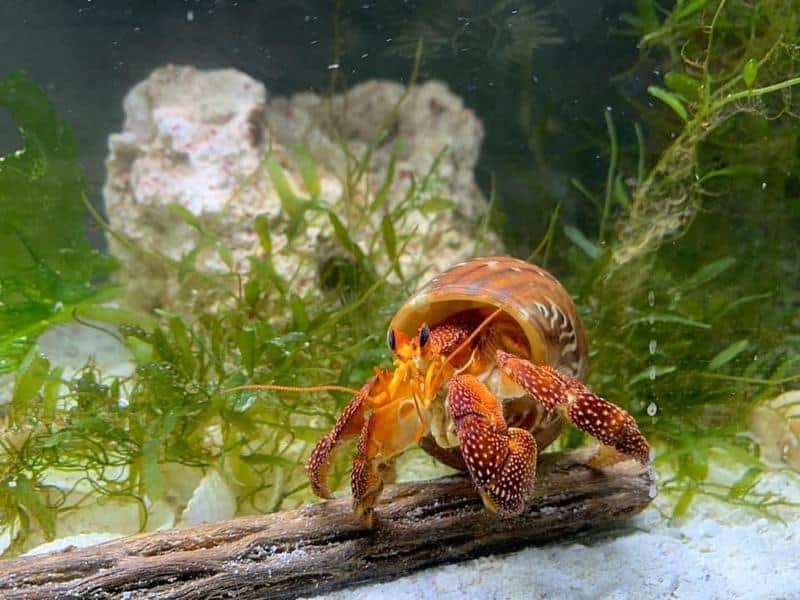
Pelleted hermit crab food can be fed once a day, while fresh foods (such as apples, carrots, kale, and bananas) can be offered roughly 2-3 times a week.
Any food that seems too large or tough for the crabs should be appropriately cut or moistened before being fed to the crabs.
The food should be given in small amounts to ensure freshness, with any remaining food removed at the end of each day.
Do Hermit Crabs Eat Every Day?
Hermit crabs can and should eat every day to ensure they receive a healthy, nutritious diet. This is especially true for commercial foods since these are their main source of nutrition.
How Long Can Hermit Crabs Go Without Eating?
Hermit crabs can survive from a few days to up to two weeks without eating or drinking. Any longer than this and the crabs will begin to grow sick and die (though it’s likely they’re already sick beforehand if they’re refusing to eat or drink).
Also Read: What Do Crabs Eat?
Conclusion
Land hermit crabs are some of the least picky eaters you’ll find. As long as you know which of the few foods to avoid, you’ll be able to ensure the health and happiness of your hermit crabs for years to come.
